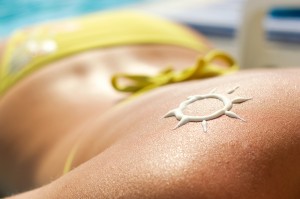Protect skin from sun damage before it begins
 One of the most powerful ways that we have in the fight against sun damaged skin is prevention. We know that sunburns and sun damage come from ultraviolet (UV) radiation. UV radiation is light that cannot be seen with the human eye because the wavelength is too small. There are two important UV wavelength ranges for the skin, UVA and UVB. Both UVA and UVB wavelengths can cause premature aging of the skin and UVB rays are particularly nasty causes of skin cancer. Incidentally, tanning booths emit both UVA and UVB radiation, just like the sun.
One of the most powerful ways that we have in the fight against sun damaged skin is prevention. We know that sunburns and sun damage come from ultraviolet (UV) radiation. UV radiation is light that cannot be seen with the human eye because the wavelength is too small. There are two important UV wavelength ranges for the skin, UVA and UVB. Both UVA and UVB wavelengths can cause premature aging of the skin and UVB rays are particularly nasty causes of skin cancer. Incidentally, tanning booths emit both UVA and UVB radiation, just like the sun.
In order to protect skin from sun damage and burns, it is critical to find something that prevents both UVA and UVB radiation from striking the skin. Clothes and hats work the absolute best at blocking rays, but few people want to wear that type of physical protection at the beach. Most people that care about their health and choose to avoid sun damage to skin opt for a lotion that they can slather or spray on their skin to act as a thin barrier for the sun’s rays. This protection comes in the form of sunscreen or sunblock.
Sunscreen vs. sunblock
There is much confusion about the terms sunscreen and sunblock, even among medical professionals. Some define sunblock as a physical barrier that reflects radiation and sunscreen as a chemical barrier that absorbs radiation. In truth, the terms are used so interchangeably that any meaningful distinction has since been lost. What is important is how well the sunscreen works, how to use it in such as way that you can protect yourself from sun damage, and how often it needs to be applied in order to maintain protection. The same thing goes for sunblock. The term sunscreen is used by everyone from dermatologists to manufacturers, so you will not see the word sunblock for the rest of this article and pretty soon you may not see in on store shelves, either.
What to look for in a sunscreen
SPF is the key. SPF is Sun Protection Factor and it is a number that is supposed to define how well the product blocks the sun’s rays. Higher SPF equals better blocking power. Most dermatologists would recommend using an SPF of at least 30 for people with lighter colored skin (e.g. European descent) and at least SPF 15 for darker colored skin (e.g. Middle Eastern descent, African descent).
It is also essential to protect skin from sun UVA and UVB radiation; something that a sunscreen should list on the packaging. A good sunscreen will contain multiple sun-blocking and/or sun-absorbing ingredients to protect skin from sun damage. Reapply at least as often as directed and remember that perspiration and water can wash away sunscreen!
Undoing sun damage to skin
So you did not protect yourself from sun damage as a child or young adult and are now suffering from prematurely aged skin. While the risk of skin cancer from blistering sunburns does not go away, the cosmetic sun damage to skin can be corrected. The dermatologist’s big gun is tretinoin emollient cream (Renova). Renova can help induce skin cells damaged by the sun to produce more collagen (interestingly only sun damaged skin cells).
Clinical studies showed that Renova improved the appearance of fine wrinkles, reduced mottled hyperpigmentation (blotchy skin) and made skin softer. While Renova was only moderately effective overall, the results were statistically significant. In other words, most people will notice a beneficial effect.
From a cosmetic surgery standpoint, acid peels, microdermabrasion, and superficial laser peels have been quite effective at reducing the hallmarks of sun damaged skin. These procedures etch off the upper damaged layers of the skin to reveal healthier skin underneath. Also, dermal fillers have been wildly successful at improving the look of facial lines and wrinkles. As you may expect, though, these cosmetic surgery procedures are more effective in people with less extensive sun damage.
